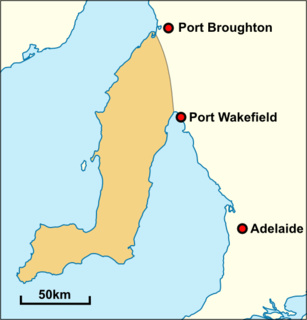The Diyari, alternatively transcribed as Dieri, is an Indigenous Australian group of the South Australian desert originating in and around the delta of Cooper Creek to the east of Lake Eyre.
The Kaurna people are a group of Indigenous Australians whose traditional lands include the Adelaide Plains of South Australia. Pronunciation of the word "Kaurna" varies slightly by the background and origin of the speaker; the most common is English, sometimes, native [ɡ̊auɳa] or, less often,. They were known as the Adelaide tribe by the early settlers. Kaurna culture and language were almost completely destroyed within a few decades of the European settlement of South Australia in 1836. However, extensive documentation by early missionaries and other researchers has enabled a modern revival of both language and culture.

The Ngarrindjeri people are the traditional Aboriginal Australian people of the lower Murray River, western Fleurieu Peninsula, and the Coorong of the southern-central area of the state of South Australia. The term ngarrindjeri means "belonging to men", and refers to a "tribal constellation". The Ngarrindjeri actually comprised several distinct if closely related tribal groups, including the Jarildekald, Tanganekald, Meintangk and Ramindjeri, who began to form a unified cultural bloc after remnants of each separate community congregated at Raukkan, South Australia.
The Mirning, also known as the Ngandatha, are an Indigenous Australian people whose traditional lands lay on the coastal region of the Great Australian Bight extending from Western Australia into south-west South Australia.

The Narungga, otherwise known as the Narangga, are a group of Indigenous Australians whose traditional lands are located throughout Yorke Peninsula, South Australia.
The Maraura or Marrawarra people are an Aboriginal group whose traditional lands are located in Far West New South Wales and South Australia, Australia.
Geawegal is the name for an Australian Aboriginal people who were recorded as inhabiting an area of the Hunter Valley in eastern New South Wales, north of Sydney. This identification has been recently questioned by Jim Wafer of Newcastle University, who also reconstructs the original name as Kayawaykal.
The Barindji, also written Parrintyi, are an indigenous Australian people of the state of New South Wales. They are to be neatly distinguished from the Paaruntyi, who spoke a similar language but whom they called the spitting people.
The Jarildekald (Yarilde) are an indigenous Australian people of South Australia originating on the eastern side of Lake Alexandrina and the Murray River.
The Ngintait, or Ngindadj, were an indigenous Australian people of the northwest corner of the state of Victoria, and partly in South Australia. 9 people, all of one family, claim descent from the tribe, which was dispersed in the 19th century.
The Bodaruwitj, also referred to in some early sources as the Tatiara, are an indigenous Australian people of the state of South Australia. Some authorities believe they are extinct. David Horton believed they were the group his sources referred to as the Bindjali people.
The Ngarkat (Ngargad) were an indigenous Australian people of the state of South Australia, now believed to be extinct.

The Arabana, also known as the Ngarabana, are an indigenous Australian people of South Australia.
The Yankuntjatjarra, otherwise written Jangkundjara, are an indigenous Australian people of the state of South Australia.
The Antakirinja, otherwise spelt Antakarinya, and alternatively spoken of as the Ngonde, are an indigenous Australian people of South Australia.
The Ngameni are an indigenous Australian people of South Australia who once spoke the Ngameni language.

The Wirangu are an Aboriginal Australian people of the Western coastal region of South Australia.
The Kaiabara are an indigenous Australian people of the state of Queensland. Rather than an independent tribe, they may have been a horde of the Gubbi Gubbi.
The Ngawadj, also spelt Ngawait were an Aboriginal Australian people of the upper Murray River in South Australia.
The Portaulun were an indigenous Australian people of South Australia.
This page is based on this
Wikipedia article Text is available under the
CC BY-SA 4.0 license; additional terms may apply.
Images, videos and audio are available under their respective licenses.



